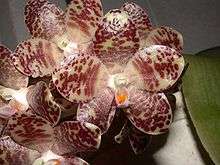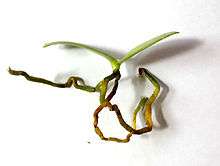Phalaenopsis gigantea
Phalaenopsis gigantea is named for the giant size of its leaves, which can grown over 2 feet in length on a mature plant. This orchid is endemic to Borneo and was first described in 1909. It is the largest known Phalaenopsis species.[1]
| Phalaenopsis gigantea | |
|---|---|
 | |
| Flower of Phalaenopsis gigantea | |
| Scientific classification | |
| Kingdom: | |
| (unranked): | |
| (unranked): | |
| Order: | |
| Family: | |
| Subfamily: | |
| Genus: | |
| Species: | P. gigantea |
| Binomial name | |
| Phalaenopsis gigantea | |
| Synonyms | |
| |
Species Description

Phalaenopsis gigantea seedling

Phalaenopsis gigantea inflorescence
- A very short monopodial stem with 5-6 large silvery-green pendent leaves that can measure over 60 cm across
- flowers are ~5 cm across (up to 6.5 cm), cream background with raised red-brown spots, and varying degrees of green around the column, waxy
- Mature, specimen-size plants are capable of producing hundreds of flowers on pendent, branching inflorescences reaching 40 centimeters
- blooms have sweetly fragrant citrus scent
- flowers can last many months
- inflorescence can rebloom over many seasons [2]
- Although widespread belief that this orchid takes anywhere from 8 to 12 years for a seedling to reach flowering size, it may be possible to flower seedlings in 4 years with ideal culture [3]
Species variants
- Phal. gigantea var aurea: has a brighter yellow background color throughout the sepals and petals [1]
Growing Conditions
- warm to hot growing orchid[2]
- although not difficult to grow, (gigantea) seedlings take significantly longer to reach maturity than other species
- particularly susceptible to rot if water gets trapped between the leaves
- allow potting media to dry out completely between watering
- Phal. gigantea needs its entire root system to keep the large leaves hydrated, so as a result is very sensitive to getting its roots disrupted
- prefers higher light than most phalaenopsis[1]
gollark: ↑↓
gollark: πυθον
gollark: ρυστ
gollark: ***ἁσκελλ***
gollark: See, even with joins instead of nouns, I think you understood that.
References
- Peter Lin, Phalaenopsis Gigantea: Giant of the Genus IPA Journal - Phalaenopsis - Winter 2003 issue
- IOSPE
- Phalaenopsis gigantea (J.J.Smith 1909) Accessed 10/15/2012
External links


This article is issued from Wikipedia. The text is licensed under Creative Commons - Attribution - Sharealike. Additional terms may apply for the media files.